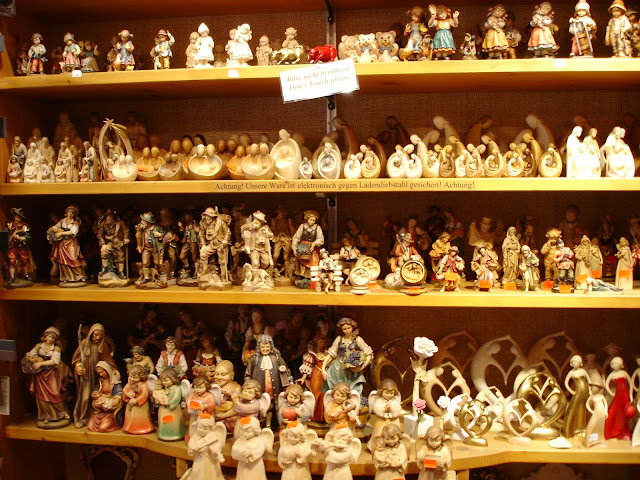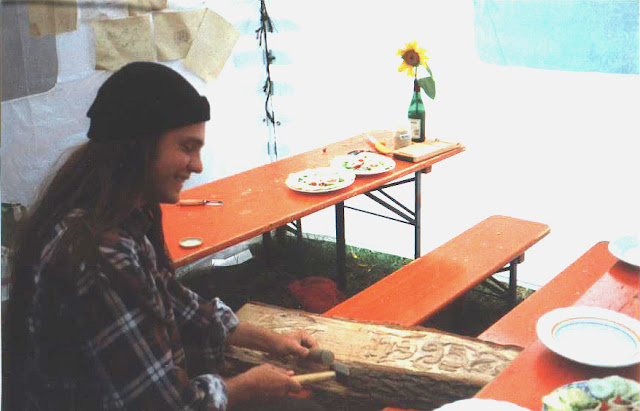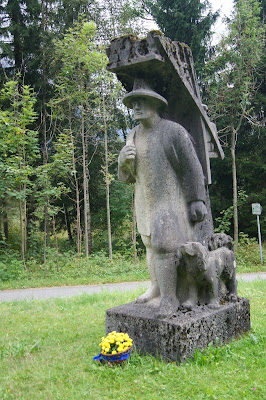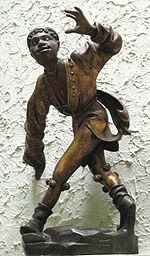The town of Oberammergau is in Bavaria, the most south-easterly state in Germany, not far from the border with Austria. It is famous for the Passion Play, which depicts the suffering and death of Jesus and has been staged there every ten years since 1634.
The town and the area around it are also renowned for the woodcarving tradition that predates the first performance of the play. In 1508, the Florentine statesman Francesco Vettori visited Oberammergau and described it as a 'very healthy but poor village, where most of the inhabitants were fine woodcarvers. The villagers were famous for carving crucifixes and different scenes inside a walnut shell.' These kinds of sculptures are still produced today; this example was carved by Joachim Seitfudem:
In the 18th century, the woodcarvers from this area would travel around Europe carrying a distinctive type of rack called a 'Kraxe', on which they carried carvings for sale.
The peddler, called a 'kraxenträger', is a figure whose hard work and resilience is still celebrated in the area today, both in public statues and in sculptures by contemporary carvers.
Carvings made in Oberammergau can still be seen in many places outside of the area, even in Britain. This nineteenth-century crucifixion scene in the church of St Carantoc, near Newquay in Cornwall, is an example of a piece made by carvers based there.
There are quite a few shops selling woodcarvings in Oberammergau and I visited several of them. It was interesting to see that certain figures and subjects came up again and again. The kraxenträger is one, as is the crucifixion of Jesus, St George slaying the dragon, St Hubertus (who is associated with hunters) and of course Nativity scenes, amongst others. Another secular subject that particularly interested me were the many figures of morris dancers, taken from famous original versions which were carved in 1480 by the Munich-based sculptor Erasmus Grasser.
In one shop, the staff were happy to explain about the process of making the carvings.
They said that their sculptures were still carved in Oberammergau, however the pressure of producing enough to satisfy demand at a reasonable price meant that most were now made using a pantograph (a copying machine) rather than by hand. A bronze master figure was produced and used to create other figures, which could be scaled up or down by setting the machine differently. Such devices have been in use for centuries and, in a world of computer controlled processes, machines working from a metal master figure are quite traditional in themselves. Once carved, the figures would be checked and finished with wax or painted by hand.
I have been told, by another local carver, that German law also says that if a sculpture has had at least ten percent of the work done by hand, it can be sold as 'hand carved'.
Some larger figures will be roughly shaped using a computer-controlled routing device and then carved by hand over a period of two or three days to speed things up. To be honest, this seems fair enough to me in a commercial context. Most carvers would use machinery, such as a bandsaw, to roughly shape a sculpture nowadays and the hand carving would still require a lot of skill to execute well.
The same person told me that some of this carving work is sometimes also done outside of Germany, in countries such as Rumania, then sold by retailers in this area as locally-made. I don't believe that the shop shown above does this but apparently some other, less honest, places do.

I saw three kinds of wood being used to produce carvings. Larger ones and hand-carved small figures were produced using timber from the lime or linden tree (Tilia sp.), as it is soft and easily worked. Smaller carvings, especially those made by using a pantograph, were also often made from the harder timber of sycamore (Acer pseudoplatanus), which is called 'Ahorn' in German. Traditionally, this would usually be sourced from the South Tyrol region of Italy, but nowadays it sometimes had to be bought in from further afield. In one shop, a small number of carvings were made from pine or larch timber. This didn't seem to be a common practice although I did see an interesting grave marker, also carved from softwood, in a graveyard in the nearby village of Bad Kohlgrub.
This region is quite staunchly Catholic and many woodcarvings of saints, Jesus or Mary his mother could be seen on local shrines or around important features such as springs of drinking water.
To make the wooden carvings ready to be placed outdoors, they are coated with layers of a special compound made from three different kinds of powdered chalk, one of which is Champagne chalk from France. The number of coats used varies between three and seven, with each layer being allowed to dry and then carefully sanded before the next is applied, so that the finer details of the carving aren't obscured. The figure can then be painted and gilded.
The village of Bad Kohlgrub is not far from Oberammergau. One of the most respected local woodcarvers lives and works here; Hans-Joachim Seitfudem. This is his shop:
I was in the village to celebrate the wedding of his son, Joachim, who is also a woodcarver. Jo kindly explained a lot about his father's work, as Hans-Joachim is friendly but speaks very little English and my knowledge of German is not much better.
Unlike the larger woodcarving outlets in Oberammergau, Hans-Joachim does the majority of his carving by hand using linden timber and does not use replicating machines. He is an extraordinarily quick and skilled worker, having explained to Jo that a carver must be fast to make a living.
I was very interested to notice that, even though all his work is done by hand, two sculptures of the same subject would be almost identical.
There wasn't much in the way of reference material visible around the work area, so I suppose that this must come from familiarity with and repetition of the carving process over decades of work and knowledge passed on from master to pupil. All of the other carvers that I spoke with in the area knew of Hans-Joachim and respected his work very highly.
Smaller figures would have hands and sometimes forearms carved separately, then glued to the rest of the figure using a dowel for strength. This meant that the wood grain could run along both the legs and the hands, making them stronger and less likely to snap.
Hans-Joachim is one of the last master carvers in the area to have had apprentices. It is very expensive for a master woodcarver to train an apprentice, so most young people who wish to learn the trade nowadays go to a carving school. The majority of them are not from the local area, coming instead from other places to study because of the reputation that Oberammergau has. However, it was said to me that the quality cannot be expected to be the same: learning from a real master being far superior.
I did notice that the work of younger carvers that I saw in Oberammergau was often technically excellent, but that attempts to produce their own style often seemed to lack self confidence. Many would emulate other styles and it led me to wonder if the strong tradition of the area held them back from really exploring new forms of expression in woodcarving. At the same time, carving has been around for thousands and thousands of years and has been practised all over the world. It can be a struggle for any carver to find new approaches to it.
Thanks to Jo, Hans-Joachim, Toni and to all of the carvers of the Ammergau Alps who shared their knowledge with me.






